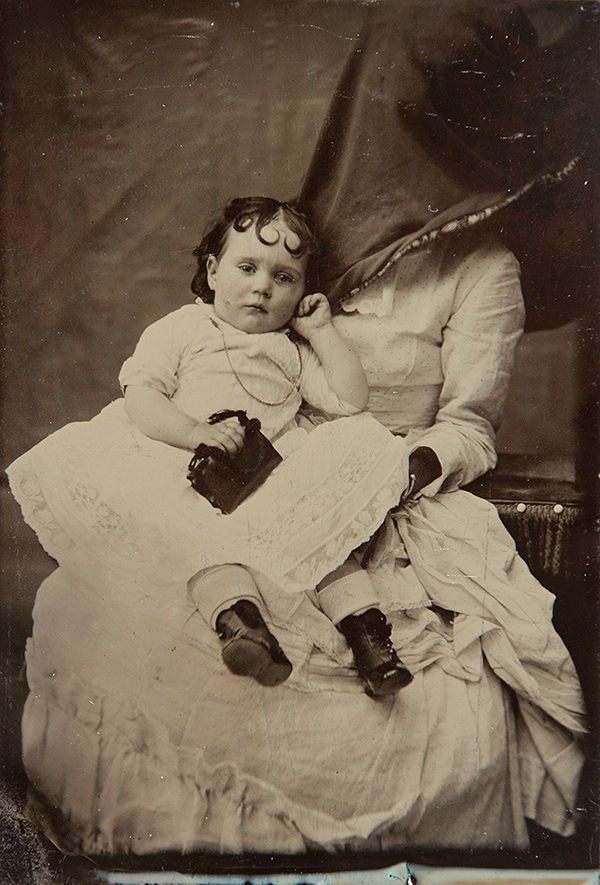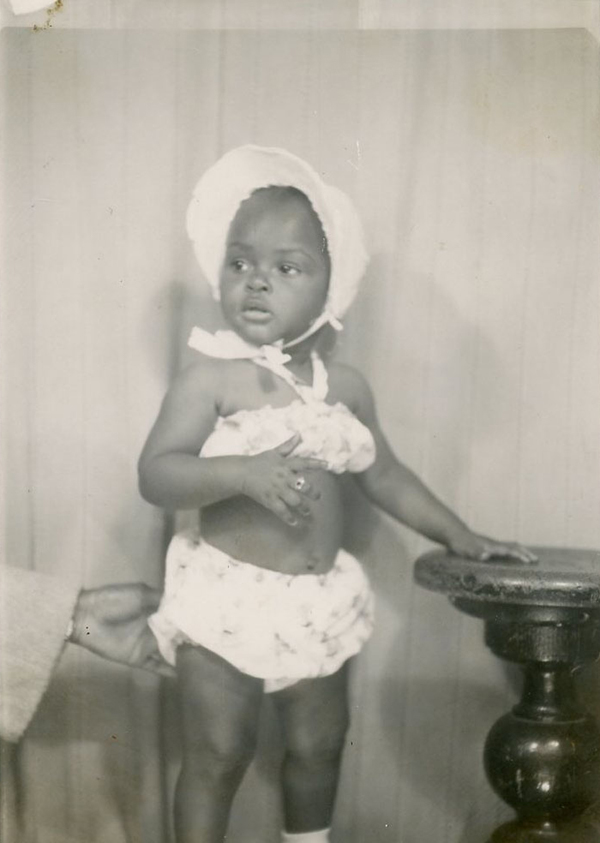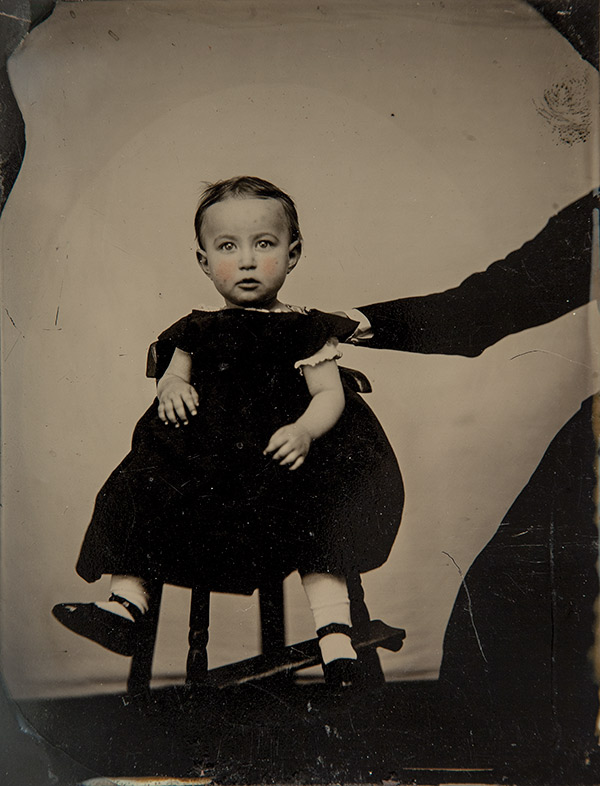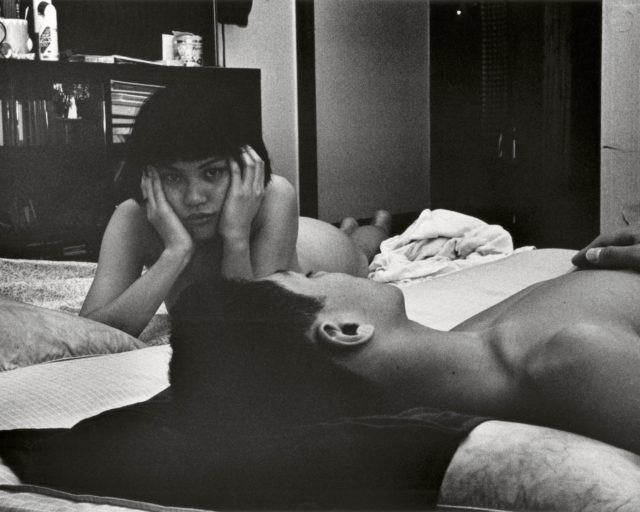Hidden Mothers

Photographer unknown, ca. 1860s–70s
Courtesy the collection of Lee Marks and John C. DePrez, Jr.
When I moved to Ohio in 2014 for a teaching job, I had no idea what kinds of artists and friends I might encounter. One of the first people I came to know was Laura Larson, a professor of photography at Ohio University, who was living in Athens, Ohio. She gifted me her new book, Hidden Mother; I’ve been wanting to write about the way it moved me ever since. In the slim volume, Larson braids together her personal narrative of adopting her now nine-year-old daughter with a history of nineteenth-century photographs of “hidden mothers”: children propped up for the camera by their mothers, who are literally dislodged from the image through drapery, plate scratching, or other methods of erasure. The writing behaves at once as memoir, poetry, biography, and creative nonfiction, keeping company with the likes of Maggie Nelson, Sarah Manguso, Wayne Koestenbaum, and, of course, Roland Barthes. But its content, which moves through the tender and the uncertain to arrive somewhere in between, feels entirely its own.
Carmen Winant: I am struck by how, as you describe in this book, you came to meet your daughter through pictures. She was in an orphanage in Addis Ababa; you were across the world in Athens, Ohio. As someone who spent their life dealing in pictures—and perhaps being skeptical of their capacities to transmute truth or evidence—did this experience affect your understanding of photographs?
Laura Larson: I received approximately fifteen photographs of Gadisse during the legal process of the adoption with a two-month gap between the first photograph and the second set of images. Bear in mind I had already waited nine months while my application was being processed and that time had passed relatively easily. But, once I had an image, I became a mother, Gadisse’s mother, and she became my daughter. It felt real to me and disconcerting, too—extraordinary to feel this intense attachment based solely on a photograph. I’ve spent so much time as an artist thinking critically about the medium; I’m not a sentimental person, and here I was, drowning in affect! There’s a speculative aspect of becoming a parent, wondering who this little person’s going to be, what will their life be like? Gadisse’s photographs supplied a screen, a real face, for those projections. I struggled to navigate those fantasies, those questions, and those very intense fears because my rudder, my skepticism, was gone.

Photographer unknown, ca. 1920s–30s
Courtesy Laura Larson
Winant: I keep thinking of this line, toward the end of the book, when you come to meet Gadisse in person: “When we first met, I hesitated to pick her up, pausing at the threshold when we became real.”
Larson: Right. Strangers were making these photographs—government officials, agency employees, visiting families. I was jealous and sad because of the contact they had with her and here I am on the other side of the world with a few digital files. Those photographs varied wildly in quality since they were all made by amateurs and this added to the strangeness of the experience. I found myself getting frustrated. Get closer! Use the flash! You could really tell when the photographer spent time with her and when she was just another child of many who was documented. There’s one photograph of her—I don’t write about it in the book—where there’s a small dry-erase board propped in the frame with her name written on it. That picture destroyed me. All of this intensified her vulnerability for me, my distance from her. So, when I do finally meet her, here is this very real person and those photographs are a very faint approximation of her. I still recognized her but I didn’t know her at all. I had anticipated this but it’s something else to see and hold your daughter for the first time after looking at her photographs for seven months.
Winant: There is a direct relationship between photographic process and healing explored in these pages. You write of the early chemistry: “During the Crimean War, collodion was also used as a kind of liquid skin to dress and seal wounds on the battlefield.” I’m struck by this fact, that the same chemicals that were used to make the Hidden Mother tintypes were used to save lives, keep limbs together.
Larson: I was really taken by the idea of how collodion’s capacity to repair a body, to make it whole again, circled back to representation—in this case, of mothers, of mothers and children, of adoption. With the hidden mothers where the emulsion is scratched off, that’s a tear in the collodion, a wound. I’m thinking of the book as a form of feminist triage! The book mends these bonds that are disguised or marginalized or severed in the photographs. You can physically repair a wound and tend to psychological pain, but trauma steeps in the body and scars remain. It’s a way of thinking of healing in a more complete way, that it’s ongoing, never resolved.

Photographer unknown, ca. 1860s–70s
Courtesy the collection of Lee Marks and John C. DePrez, Jr.
Winant: Can you speak to this in a more direct way, as it relates to your daughter?
Larson: Yes, this all comes back to the stream of photographs of Gadisse. I grew attached to her and the bond felt whole but that bond was predicated on some delicate psychological suturing. There’s another connection here too with the role of attachment in adoption. Attachment plays a fundamental role in child development but with adoption, it’s a critical aspect of healing. Forming a bond with a new parent is key to a child’s emotional health and their capacity to recover from trauma.
While I was writing the book, I took a workshop on wet collodion to get some insight into the process. This is where I learned of its role as a surgical binding agent. What I love about wet collodion is its messiness, its stickiness—there’s so much power in this liquid material. There’s something poetic about how bodily the process is; a comparison could be made to birth. Those plates stand for a physical touch between the photographer and the subject, which in turn echoes the touch of the subjects’ bodies. It’s moving to think about how healing can come from a substance so mercurial and how images—photographs of bodies—emerge from this fragile economy of light and chemistry.
Winant: Can you talk a little bit about the structural form this project takes? The short, interweaving sections recall Barthes’s figures, so notable in A Lover’s Discourse (1977). This form allows you to weave together distinct narratives: your own personal history, and a larger, photographic one.
Larson: Barthes looms large in this work—his notational forms, short chapters, circling structures, prismatic effects. There hadn’t been any scholarly writing about hidden mother photographs, so for a while, I internalized a pressure to position the practice within a critical framework. I realized at a certain point that the writing could be organized around my experience as a photographer, rather than as a historian or critic, and that was enormously freeing. I know the physical demands of making a photograph, that it’s a form of emotional exchange, and the ethical and political questions around representation, and the pleasures of experimenting with shooting and printing. I wanted my identity as a maker of photographs to run up against my identity as a mother-to-be.

Photographer unknown, ca. 1860s–70s
Courtesy the collection of Lee Marks and John C. DePrez, Jr.
Winant: When did this book begin to come into focus?
Larson: The project was seeded by an essay I wrote when I was assembling my adoption dossier. I was introduced to the hidden mother photographs at the same time and I knew I wanted to tell the story through these images. The photographs were like a release valve for all my longing, a distraction from the situation at hand, and I could take shelter in them. I didn’t want to write a conventional memoir or a confessional. I’m an intensely private person, so considering its subject, I think it’s a reserved work. The photographs allowed me to spin out the different parts of the story.
Winant: Had the adoption been formalized when you began to write? So much of it takes place in the beginning months, the back and forth, the bureaucracy, the anticipation.
Larson: I actually wrote the book when Gadisse was four. We were still in the moment when childcare is so physically demanding. The adoption process is so disorienting, it would have been impossible to write the book when she was a baby. During those early years as a single parent, I had no time to make work, to get to the studio, but I could sneak time to write. Not that this is a small thing! When I was weaning her from co-sleeping to being in her own bed, I would sit on the floor of her room by the door. It would typically take her an hour to fall asleep and she needed me close by. So, in the dark, I would write on my laptop, pieces of ideas, between comforting her, singing. It started with writing around and about each of the photographs. The book grew from these fragments and the fragments were tied to the actual experience of mothering. Its structure developed as a constellation from that writing, rather than linear essay.
Winant: Has that informed the way you work in the studio as well?
Larson: Writing this book has fed back into my studio practice in really positive ways. Historical research plays an important role in my work but typically as a point of departure. In working directly with appropriated imagery, I’ve shed some baggage around authorship, baggage I didn’t even know I had, and I’m excited about where this is taking the work.

Photographer unknown, ca. 1920s–30s
Courtesy Laura Larson
Winant: I’ve been making a lot of work about motherhood lately, and all that attends it. It is an area that’s made me nervous. I’ve worried that I might cloister myself, that I might not be considered serious. Can you talk a little bit about taking on motherhood—not to mention adoptive motherhood, and single motherhood—as the subject of this work?
Larson: I share these fears, too. The motherhood ghetto is one of the ghettos where women’s work is placed. So, with that understanding, I felt less anxious about that space because I know those terms of marginalization well and I’m committed to resisting those terms, the outskirts, so to speak. I’ve been very fortunate to have mentors who were role models not only as artists and scholars but mothers as well: Patricia Mathews, Martha Rosler, Mary Kelly. To be honest, I was more terrified of writing an autobiographical work—to share my experience publicly, especially the loss of my own mother, with whom I had a difficult relationship. I felt vulnerable writing an autobiographical work that takes Barthes’s writing as its model. To answer your question, I wanted the book to weave together the strands of experience that shaped my desire to be a mother and how they’re intimately tied to my work as an expression of how I want to live in the world.
Winant: Perhaps it is because I am not close to this experience, but I cannot recall reading any narratives about adoption, especially in this context. I only realized that during my first reading of your text. It feels like a void.
Larson: Adoptive motherhood is understood as a second choice, the option available if you can’t get pregnant and, to a certain extent, if you become a single mother by choice. Since I was in my twenties I’ve known I wanted to be a mother, and adoption intuitively felt more primary. For me, it represented a decision to feel connected and to see mothering as an intentional, political act even with the knowledge that I will fail. Adoption is a serious and ongoing reckoning with privilege.

Photographer unknown, ca. 1860s–70s
Courtesy the collection of Lee Marks and John C. DePrez, Jr.
Winant: Yes, the line you’ve written—“With the uncertainty of our legal case, this sense of fate unmoors and my fears bloom that I am complicit in another mother’s loss”—stayed with me. It certainly complicates the already complicated terrain of motherhood, within and outside of artwork.
Larson: On a fundamental level, I think the desire to have children is a selfish act. I don’t mean this in a judgmental way. In our case, there’s no escaping the losses that are the very condition of her adoption and the implications for our life as a transracial family.
Winant: The hidden mother photographs themselves strike me as so desperately sad, and laced with trauma. They play to my deep fear that mothers need fade into the background, literally disappear for the sake of holding up their children. You approach them with more nuance in your writing.
Larson: Many of the photographs are so casually and profoundly violent. I didn’t think I had much to add to this other than to say, look at this, and let those images speak for themselves. Why not photograph the mother and child together? Some of the photographs are so extreme that it veers into black comedy—who are these monsters? Those ruptures open up the cultural schizophrenia around mothers. But, I found so many images where the bond between mother and child was so undeniably there—a mother playing peekaboo with the camera, the infant’s gravitational pull toward the mother’s obscured body—and I love these moments of insistence. I’m here! She’s here! Loss is a defining feature of mothering but I read ambivalence in these images as well. I know that I was already anticipating those feelings.

Photographer unknown, ca. 1860s–70s
Courtesy the collection of Lee Marks and John C. DePrez, Jr.
Winant: Right—as you say, “Like a hidden mother, I was bound to and separated from my daughter.”
Larson: Yes. Her first mother is hidden too, and to a lesser extent, the women who cared for her in Addis Ababa. I took great comfort in the photographs I received of Gadisse with the house mothers. I liked seeing her held by these women even though it was also very painful. It’s important to know that the nannies are mothers too and providing care for children is how they support their own. The work of mothering isn’t tethered to biology and I wanted the book to account for that labor in a broader framework.
Winant: A substantial portion of the book revolves around descriptions of Gadisse’s image, before you came to meet her in person. Can you speak about the decision to include only a single image of your daughter, at the book’s end? Neither of your faces appear; her little body is turned toward the laptop camera.
Larson: Hidden Mother is my story and I purposely withheld images of Gadisse because she’ll tell her own story someday. She hated having her photograph taken as a baby so the Photo Booth application on my laptop was the only way I could make photographs of us. In the photograph, we’re embracing, but her body’s turning to see herself on the screen, away from me. The photograph crops out our faces but you can see our bond through the touch of our bodies. It’s my nod to Lacan’s mirror stage (and to Mary Kelly too) as refracted through adoption—the moment when the child recognizes their identity as separate from the mother’s. We’re bonded, but she’s already moving away from me, like all children do. Gadisse came to me already separate, and separated from her first mother. Her experience of the world will be radically different than mine because of her race so I’m thinking of that rift, too.

Courtesy Saint Lucy Books
Winant: I’m struck here by your consideration of Barthes’s writing on his mother, Henriette, whom he mourns, seizing on a single picture of her five-year-old self. Though, you write, “He doesn’t reproduce the photograph in the book, and the text pivots on its deliberate withholding. Echoing this loss, he suggests that the medium itself is an invocation of the maternal—a subject and experience both present and lost.”
Larson: Barthes’s casting of photography as a maternal medium is so radical because it doesn’t privilege the idea of birth as the apotheosis of mothering. By this I mean the studium is all cause and effect while the punctum is wild and eschews this tidy economy. He insists on the looping and irrational rhythms of photography’s attachments, and this certainly rang true for my experience of feeling like a mother through those photographs. His sentences about seeing Henriette restored in the Winter Garden photograph—how looking back is one and the same with the present. He’s writing of losing her but there’s this devastating sense of how her wounds—I’m thinking of her parents’ divorce—become Barthes’s, too.
Winant: You make reference to Barthes’s withholding in the book specifically when you write about the second set of images you received of Gadisse, the images that showed her as thriving, two months after you received her referral photograph.
Larson: The first photograph was devastating, which made the second set so shocking in their difference. Those photographs are my Winter Garden photograph. I would never print them, out of respect for her privacy, but those images do contain her ineffable self. I part ways with Barthes’s mournful refusal by including the photograph of us, even if it’s a modest disclosure. Its reveal comes at the end of the book. It’s our happy ending even though it alludes to the complications that we face.
Hidden Mother was published by Saint Lucy Books in 2017.

























